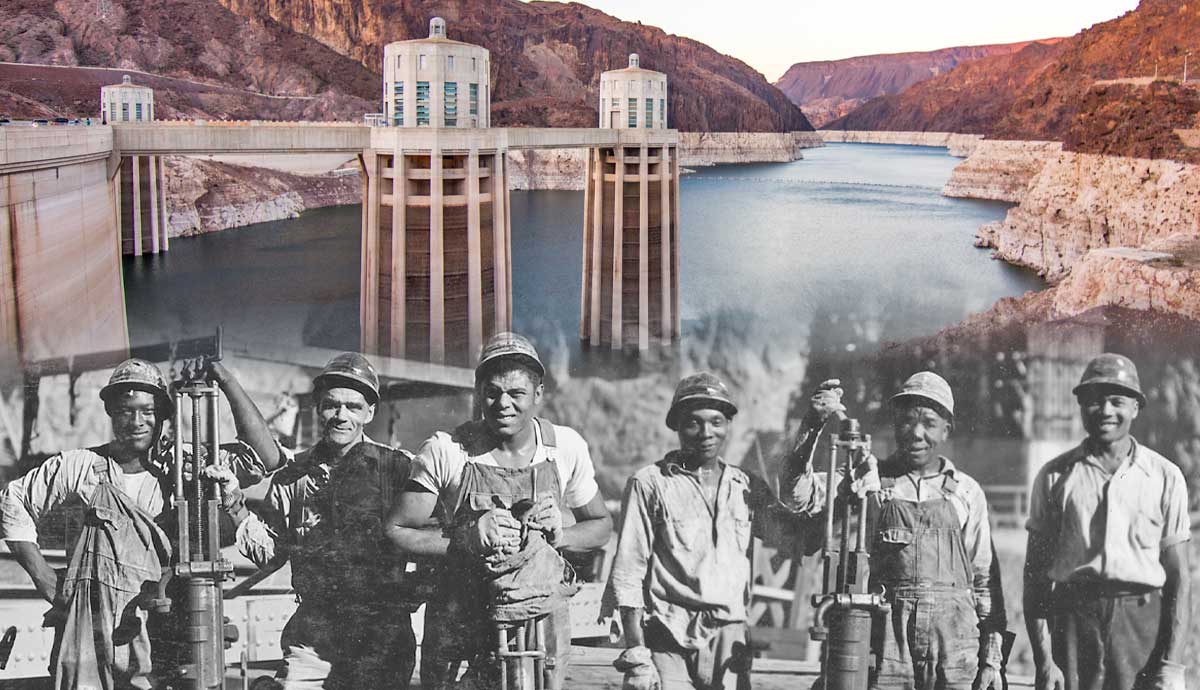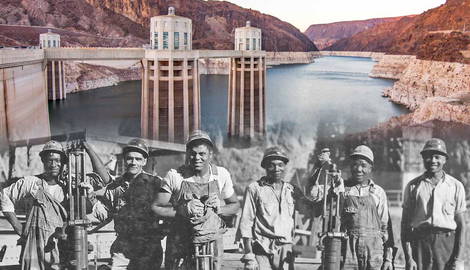
Since 1936, the year it was completed, the Hoover Dam, a monumental feat of American engineering, helped tame the Colorado River and reshape the landscape of the American Southwest. Perched on the border of Arizona and Nevada, it is far more than a hydroelectric dam. The Hoover Dam is actually an innovation symbol and a testament to resilience during the Great Depression era. However, many don’t know that the Hoover Dam’s story is filled with fascinating trivia and surprising twists. We will share with you below ten facts you didn’t know about this engineering marvel that captured imaginations for nearly a century.
1. Nazis Planned to Blow It Up During World War II

This was in November 1939, before the U.S. became involved officially in WWII when officials uncovered a Nazi plot to sabotage the Hoover Dam. They saw the potential value of damaging and disrupting such a key American asset. The Nazis knew that the Hoover Dam powered the growing airplane manufacturing industry in Southern California. This industry was vital, after all, to the war effort.
The U.S. government took key security measures to counter these Nazi threats by increasing surveillance and patrols around the Hoover Dam. Authorities also planned to camouflage the dam to make it less visible from the air. Also, anti-aircraft guns were stationed in the area. On top of that, they heavily restricted access to the Hoover Dam. For example, boats were forbidden from coming too close, and roads leading to the dam were heavily guarded.
Gladly, the Nazis never succeeded in attacking the dam directly. Following the attack on Pearl Harbor in December 1941 and the U.S. entering the war, the dam was completely closed to visitors until 1945, the year the war ended.
2. More Than 100 Workers Died During the Construction of the Dam

The construction of the Hoover Dam took place between 1931 and 1936, and during these years, 96 deaths of workers were officially recorded. This was the result of various industrial accidents, such as falls, equipment malfunctions, and machinery incidents.
However, this figure is contested as it does not include unrecorded or indirect fatalities. For example, 42 workers were reported to have died later because of conditions like heatstrokes or carbon monoxide poisoning.
The tragic aspect of the construction of the Hoover Dam can be found in the first and last recorded deaths. The first worker who died was surveyor J.G. Tierney. He had drowned on December 20, 1922, in the Colorado River. The last recorded death was of his son, Patrick Tierney, who died exactly 13 years later, on December 20, 1935, during the final stages of construction.
3. The Original Name of the Hoover Dam Was Actually Boulder Dam

During its early planning and construction stages, the Hoover Dam was originally known as the Boulder Dam. Its name was derived from Boulder Canyon, which was one of the proposed sites for the construction. Despite the fact that the Hoover Dam was built in Black Canyon, the name Boulder Dam stuck.
During the construction of the dam in 1930, Ray Wilbur, Secretary of the Interior, declared that the dam would be named in honor of Herbert Hoover. The latter was the sitting president at the time, and he pushed for the approval of the dam when he served as Secretary of Commerce in the 1920s.
In 1932, Hoover lost the presidential election. His successor, Franklin D. Roosevelt, refused to support the name. That’s why, in 1933, the Roosevelt administration renamed the dam officially as “Boulder Dam.” Fast forward to 1947, and this was when Congress passed a resolution to rename it all over again as “Hoover Dam” to honor Herbert Hoover’s contributions to the project.
4. The Hoover Dam Builders Entertained Themselves and Onlookers

It’s true that the builders of the Hoover Dam worked under grueling conditions. However, they were so creative when it came to entertaining both themselves and onlookers. Many people came to watch such a massive construction project. For example, the “high scalers,” or workers who dangled themselves from ropes on the canyon walls to clear loose rock and prepare the surface for construction, were the most entertaining to onlookers due to their daring stunts.
Some of these high scalers performed aerobatic tricks to lighten the mood and pass the time. They also used to engage in playful banter while suspended hundreds of feet in the air in a bid to entertain onlookers. They even sometimes pretended to fall while swinging from their ropes. Flipping in midair was also one of the entertaining stunts they pulled. More so, some high scalers would even use their tools, like jackhammers, as makeshift drum sets, which was also entertaining to both workers and visitors.
5. It Was the World’s Tallest Dam

In 1936, when the Hoover Dam was completed, it was standing at 726 feet, making it the tallest dam on Earth. Considering the challenges in terms of logistics and engineering when it comes to building such a colossal structure in the difficult conditions of the Black Canyon on the Colorado River, achieving this record-breaking height was a massive accomplishment for its time.
However, the height of the dam did not only serve as a symbol of American ingenuity. It had a much more important purpose, and it was to control the flow of the Colorado River. This allowed the dam to provide irrigation water to the surrounding areas, and to also generate hydroelectric power. The massive size of the dam also permitted it to store a vast amount of water in Lake Mead. The latter is the largest man-made reservoir in the U.S.
The Hoover Dam remained the world’s tallest dam for many years until it was surpassed in 1968 by Northern California’s Oroville Dam, which is 770-foot-high. Today, it is the second-tallest in the U.S., while the Jinping-I Dam in Liangshan, Sichuan, China, is the tallest dam in the world, at 1,001-foot-high. The latter became operational in 2013.
6. Boulder City Was Built Specifically for Hoover Dam Workers

In the early 1930s, no nearby infrastructure was capable of supporting the thousands of workers involved in the construction of the dam. This is why the U.S. government built Boulder City, a fully planned community with the only purpose of housing and providing for the dam workers and their families. Boulder City was located just a few miles from the construction site in the Nevada desert.
The city was designed to be a model town with homes, schools, stores, as well as recreation facilities. It had a capacity to house 5,000 workers at its peak. There was a strict code of conduct applied at Boulder City, such as a ban on alcohol and gambling. The objective behind such measures was to maintain order and productivity among the dam workers. While the living quarters inside the city were basic, they were also comfortable. This helped keep workers relatively happy and healthy despite the harsh and difficult working conditions.
After nearly three decades, the federal government transferred control of Boulder City. 1960 was when it was officially incorporated as a city.
7. It Led to the Creation of America’s Largest Reservoir

When the Hoover Dam was constructed, it led to the creation of the United States’ largest reservoir, Lake Mead. The latter was formed by blocking the Colorado River and is located along the border between Arizona and Nevada. Lake Mead is a critical water storage facility for the Southwestern U.S., and at maximum capacity, it can hold over 26 million acre-feet of water. This can cover 247 square miles.
Millions of people in California, Arizona, and Nevada rely on Lake Mead as a source of water thanks to its vast capacity and size. It supplies hydroelectric power through the generators of the Hoover Dam. It also supports irrigation for agriculture, which provides drinking water for several cities, including Las Vegas.
The massive water volume of the lake also maintains the Colorado River’s flow to downstream communities. However, it’s worth noting that the water levels of Lake Mead have been steadily declining. This is due to increased water demand and prolonged drought.
8. It Was Constructed to Tame the Wild Colorado River

The primary objective behind building the dam was to control the often destructive floods of the Colorado River. The latter was famous for its unpredictability, causing devastating floods that wiped out towns, crops, and infrastructure in California, Arizona, and Nevada.
Managing the Colorado River became an urgent priority for the government in the early 20th century. This was when settlers expanded westward. The Imperial Valley in California suffered devastating floods in the early 1900s. This happened particularly during the infamous 1905 flood that resulted in the creation of the Salton Sea. Events like these reminded authorities about the need for a massive flood-control project. This was when the U.S. Bureau of Reclamation proposed building a dam that would help regulate the river’s flow in a bid to prevent flooding and, at the same time, store water for irrigation and generate hydroelectric power.
After being approved in 1928 and started in 1931, the Hoover Dam tamed the Colorado River and transformed the arid Southwest into a stable region for settlement and agriculture.
9. The Hoover Dam Required Around 4.5 Million Cubic Yards of Concrete to Build

Massive resources were invested in the construction of the Hoover Dam. In total, it required 3.25 million cubic yards of concrete, which is enough to pave a two-lane highway from San Fran to NYC, in addition to 1.11 million cubic yards for the power plant and surrounding structures to build the Hoover Dam. The price tag of the project stood at $49 million at the time, which is equivalent today to around $890 million when adjusted for inflation.
Innovative techniques were employed by engineers to handle the vast amounts of concrete. For example, to prevent cracking, they were pouring concrete into massive blocks while using an intricate network of pipes through which cold water was circulated, which allowed to rapidly cool the concrete. This permitted the construction workers to finish constructing the dam in just five years. This was two years ahead of schedule.
10. It Caused Around 600 Seismic Events

During its early years of operation, and despite the fact that the Hoover Dam was built to control the Colorado River, it ended up triggering several earthquakes in the region. From 1935 to 1941, when the dam and Lake Mead were filling for the first time, more than 600 small earthquakes were recorded. When the massive weight of the water in a reservoir that is newly formed puts pressure on faults in the crust of the Earth, it triggers a phenomenon known as reservoir-induced seismicity.
In 1939, a 5.0-magnitude earthquake struck in the area. It was the largest of the earthquakes induced due to the Hoover Dam. Tremors took place mainly around the reservoir, while the frequency of the earthquakes decreased gradually as Lake Mead reached full capacity.
Scientists tend to believe that the sudden change in pressure, caused by the filling of millions of gallons of water, caused the reactivation of ancient faults in the area that had been dormant for centuries.










